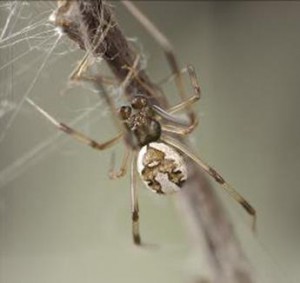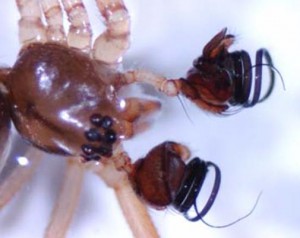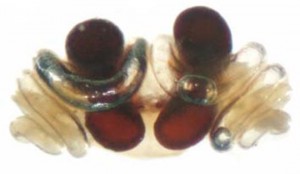
Adult male redback spider (Latrodectus hasselti)
Palps: The male’s copulatory organs are called the pedipalps (or ‘palps’, below). They are paired anterior appendages of the cephalothorax (or ‘head’). They look like two small boxing gloves (above). At the tip of each palp is a long coil, called the embolus (black coil in figure). It is the embolus that is inserted in the female at copulation. The sclerite at the tip of the embolus breaks off, remains inside the female genitalia, and acts as a sperm plug (Snow et al 2006). In the photo below, the upper palp has been used in mating (sclerite missing), the lower palp has not been used.

Cephalothorax and palps of adult male
Spermathecae: The female’s sperm storage organs (the spermathecae, below) are also paired. and are entered via copulatory ducts that are also coiled. These spermathecae have been removed from the female. The opening into the copulatory ducts would be located behind your screen, near the centre of the photograph. The male embolus enters the duct then twists its way through the tubules until it reaches one of the spermathecae (dumbell-shaped, dark brown structures). Males use one palp their first copulation, then, even though they are often partially digested, they leave the female’s body, return to the web and court the female again (Andrade et al 2005). Then they climb back on the abdomen and insert their second embolus into her second spermatheca. During and after this second insertion, the male is often completely consumed by the female. Females can store sperm from a single copulation for up to two years (and produce thousands of offspring). Learn more about redbacks from the Australian Museum website.

Dissected spermathecae of adult female redback spider
(L. hasselti)